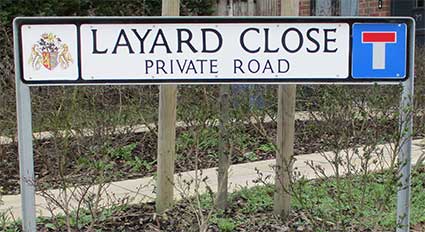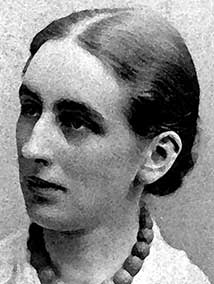
Layard Close runs off
Cauldwell Hall Road, a hundred yards or so from the crossroads with
Spring Road.

Spotted in the excellent book London street signs: a visual history of London's street nameplates by Alistair Hall (see Reading list), this 2016 sign bears the explanatory caption: ‘Stratford born, Nina Layard (1853-1935) was a botanist, antiquary, archaeologist, poet and prehistorian who made many important discoveries in her field.’ This street nameplate is on the edge of the Queen Elizabeth Olympic Park, Newham. It is important to rescue this important figure from oblivion.
Nina Frances Layard
 'Who was this woman? Without
question, she was one of the most remarkable English women to have
lived. A great archeologist, poet, botanist, humanist, radical thinker,
and champion of the underdog. A heroine, now almost unknown outside
Suffolk, unsung in the annals of English history, and not to be found
in Who's Who? or other reference books of famous or significant figures.
'Who was this woman? Without
question, she was one of the most remarkable English women to have
lived. A great archeologist, poet, botanist, humanist, radical thinker,
and champion of the underdog. A heroine, now almost unknown outside
Suffolk, unsung in the annals of English history, and not to be found
in Who's Who? or other reference books of famous or significant figures.
Nina Frances Layard was not of Suffolk stock, and arrived in Ipswich in 1890 at the age of 37. Already she was a noted poet, author, and archeologist. Deeply religious, she was radically active in her support for improving the lot of the working classes. In 1902 she had been made a Fellow of the Anthropological Institute. Later, in 1906, she was again honoured by becoming a fellow of the Linnaean Society. In 1921 when the Society of Antiquaries first allowed the admission of women, she was one of the first to gain a Fellowship. During her time in Ipswich, she was President of the Prehistoric Society of East Anglia and Vice President of the Suffolk Institute of Archaeology.
Miss Layard's father, Charles Clement, was Rector of Combe Hay, Bath. One of her brothers, the Reverend Charles Villiers Layard, held the curacy of St. Margaret's Church, Ipswich. Her father's cousin was Henry Austin Layard, the explorer, the excavator of the tombs of Nineveh, hence her deep love of archaeology from an early age.
For most of her time in Suffolk, she resided mainly in Ipswich, firstly at "Rookwood", a rambling red brick, towered edifice, in Fonnereau Road, next to the Arboretum (now the vicarage of St Mary-le-Tower Church), then at "The Moorings", in Paget Road. Both houses remain much as they were in those long-off days.
All through the years until the time her death, she was a tireless worker, visiting every archaeological excavation in Ipswich and other, far-flung areas, a valiant and persevering investigator, whose span of activities embraced the exploration of an early cemetery just beyond the Seven Arches bridge in Hadleigh Road, sites at Foxhall Road, Derby Road station, Stoke railway cutting and many others.
... Nina Layard was a free spirit long before the time of today's modern woman, and spent much of her life fighting the prejudice and disbelief that a mere woman could contribute anything serious to the science of archaeology, or any other bastion of male dominance. She would never bend in the struggle against the evils of injustice, ignorance, intolerance, personal greed, or political chicanery, and was to be a thorn in the side of the reactionary Ipswich Borough Council all her years, but always a catalyst for sensible change, improvement, and progress. There is no evidence that she was involved in the Suffrage movement, but there can be no doubt that she was a fearless protagonist of women's rights, and therefore must surely have been a staunch supporter. She had a strong social conscience, and was deeply concerned over the plight of the poor. Her early poems, particularly "A Song of Tears", demonstrated this; and the Literary World 1891 magazine, when praising her work said "she deplored the helplessness of the great, for all their good will, to relieve the suffering of the poor."
... The "Layard Collection", the results and findings of Miss Layard's heroic work on the Anglo-Saxon Cemetery at Hadleigh Road, can be seen at the Ipswich Museum, and are by themselves well worth a visit.'
[Article by George Miller Chamberlain from History Society Journal, 3rd Series, No. 11, December 2000. Quoted in The Ipswich Society Newsletter, April 2014.]
Other references to Nina Layard on this website
Ipswich Society blue plaque;
The Mill River on our Water in Ipswich page;
Valley brickworks on our Brickyards page;
Richard Felaw's House on our Tooley's and Smart's Amshouses page;
Unicorn Brewery;
Stoke Hall.

Spotted in the excellent book London street signs: a visual history of London's street nameplates by Alistair Hall (see Reading list), this 2016 sign bears the explanatory caption: ‘Stratford born, Nina Layard (1853-1935) was a botanist, antiquary, archaeologist, poet and prehistorian who made many important discoveries in her field.’ This street nameplate is on the edge of the Queen Elizabeth Olympic Park, Newham. It is important to rescue this important figure from oblivion.
Nina Frances Layard
 'Who was this woman? Without
question, she was one of the most remarkable English women to have
lived. A great archeologist, poet, botanist, humanist, radical thinker,
and champion of the underdog. A heroine, now almost unknown outside
Suffolk, unsung in the annals of English history, and not to be found
in Who's Who? or other reference books of famous or significant figures.
'Who was this woman? Without
question, she was one of the most remarkable English women to have
lived. A great archeologist, poet, botanist, humanist, radical thinker,
and champion of the underdog. A heroine, now almost unknown outside
Suffolk, unsung in the annals of English history, and not to be found
in Who's Who? or other reference books of famous or significant figures.Nina Frances Layard was not of Suffolk stock, and arrived in Ipswich in 1890 at the age of 37. Already she was a noted poet, author, and archeologist. Deeply religious, she was radically active in her support for improving the lot of the working classes. In 1902 she had been made a Fellow of the Anthropological Institute. Later, in 1906, she was again honoured by becoming a fellow of the Linnaean Society. In 1921 when the Society of Antiquaries first allowed the admission of women, she was one of the first to gain a Fellowship. During her time in Ipswich, she was President of the Prehistoric Society of East Anglia and Vice President of the Suffolk Institute of Archaeology.
Miss Layard's father, Charles Clement, was Rector of Combe Hay, Bath. One of her brothers, the Reverend Charles Villiers Layard, held the curacy of St. Margaret's Church, Ipswich. Her father's cousin was Henry Austin Layard, the explorer, the excavator of the tombs of Nineveh, hence her deep love of archaeology from an early age.
For most of her time in Suffolk, she resided mainly in Ipswich, firstly at "Rookwood", a rambling red brick, towered edifice, in Fonnereau Road, next to the Arboretum (now the vicarage of St Mary-le-Tower Church), then at "The Moorings", in Paget Road. Both houses remain much as they were in those long-off days.
All through the years until the time her death, she was a tireless worker, visiting every archaeological excavation in Ipswich and other, far-flung areas, a valiant and persevering investigator, whose span of activities embraced the exploration of an early cemetery just beyond the Seven Arches bridge in Hadleigh Road, sites at Foxhall Road, Derby Road station, Stoke railway cutting and many others.
... Nina Layard was a free spirit long before the time of today's modern woman, and spent much of her life fighting the prejudice and disbelief that a mere woman could contribute anything serious to the science of archaeology, or any other bastion of male dominance. She would never bend in the struggle against the evils of injustice, ignorance, intolerance, personal greed, or political chicanery, and was to be a thorn in the side of the reactionary Ipswich Borough Council all her years, but always a catalyst for sensible change, improvement, and progress. There is no evidence that she was involved in the Suffrage movement, but there can be no doubt that she was a fearless protagonist of women's rights, and therefore must surely have been a staunch supporter. She had a strong social conscience, and was deeply concerned over the plight of the poor. Her early poems, particularly "A Song of Tears", demonstrated this; and the Literary World 1891 magazine, when praising her work said "she deplored the helplessness of the great, for all their good will, to relieve the suffering of the poor."
... The "Layard Collection", the results and findings of Miss Layard's heroic work on the Anglo-Saxon Cemetery at Hadleigh Road, can be seen at the Ipswich Museum, and are by themselves well worth a visit.'
[Article by George Miller Chamberlain from History Society Journal, 3rd Series, No. 11, December 2000. Quoted in The Ipswich Society Newsletter, April 2014.]
Other references to Nina Layard on this website
Ipswich Society blue plaque;
The Mill River on our Water in Ipswich page;
Valley brickworks on our Brickyards page;
Richard Felaw's House on our Tooley's and Smart's Amshouses page;
Unicorn Brewery;
Stoke Hall.
Search Ipswich
Historic Lettering
©2004 Copyright throughout the Ipswich Historic Lettering site: Borin Van Loon
No reproduction of text or images without express written permission
©2004 Copyright throughout the Ipswich Historic Lettering site: Borin Van Loon
No reproduction of text or images without express written permission